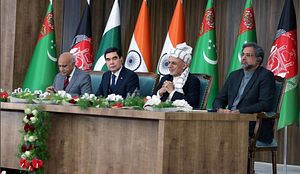When asked to comment on an early plan for the Turkmenistan-Afghanistan-Pakistan-India (TAPI) natural gas pipeline in the 1990s, Henry Kissinger said, “I am reminded of the famous aphorism — that second marriages are the triumph of hope over experience.” Time alone will tell if he was correct, but for the sake of the planet, let’s hope not.
Unlikely bedfellows had united to make the TAPI pipeline seem almost feasible until this spring, when the United States began publicly contemplating pulling its troops out of Afghanistan after 18 years of war. Without U.S. forces present to stabilize relations between the Taliban and the Afghan government, the project is less likely to proceed: the pipeline, already politically, environmentally, and technically fraught, will be too risky for many financiers. That’s a shame, because the TAPI pipeline represents one of the best near-term solutions to lowering greenhouse gas emissions and increasing energy security in South and Central Asia.
The pipeline was conceived by the Soviets as a way to get natural gas out of then-Soviet republic Turkmenistan, which has the world’s sixth largest reserves. The project floated on the edge of possibility for 30 years, when Pakistan and India’s relative energy insecurities made it attractive. The pipeline would transport Turkmenistan’s natural gas through Afghanistan and Pakistan and terminate in northern India, delivering natural gas to all three countries and providing upstream transport fees.
Though India’s per capita carbon dioxide footprint is only 40 percent of the global average, its emissions are growing quickly, outstripping China’s emissions growth rate in 2018. India has set aggressive emission reduction policies, but will likely miss them due to increased coal consumption: under Prime Minister Narendra Modi, India is building new coal plants and digging new mines, even fast-tracking the environmental approval process. Coal currently provides 70 percent of India’s energy. However, increasing natural gas as an alternative to coal is a priority for India’s government, not least because of the air pollution. In addition, India’s infrastructure is primed for natural gas: Nomura estimates over 50 percent of cars will be powered by liquefied natural gas by 2030. Reliable sources of natural gas would likely speed this transition.
In contrast, coal only contributes 1 percent of Pakistan’s energy budget — but that’s about to change. The controversial $60 billion China-Pakistan Economic Corridor (CPEC) project allocates $35 billion to building new coal plants in order to take advantage of Pakistan’s abundant, though low-quality, coal resources and provide the country with reliable, indigenous energy. Pakistan has long faced severe power shortages, causing periodic blackouts in major cities. The CPEC project has its detractors: environmentalists oppose it, citing Lahore’s status as one of the world’s most polluted cities and Pakistan as one of the 10 countries most impacted by climate change. The project is also under threat from Baloch insurgents, who have attacked elements of the Belt and Road as Chinese imperialism. A reliable non-coal source of energy would be a source of both electricity and national stability. Plus, unlike CPEC, TAPI would eventually provide revenue via transit fees, which would further increase stability.
Natural gas is far from a perfect energy source: It emits carbon dioxide and methane, contributing to global warming. Studies have linked natural gas extraction to water and soil pollution, and preliminary research suggests hydraulic fracturing (fracking) may play a role in generating earthquakes. Nonetheless, it is superior to coal. When burned in a new power plant, natural gas emits 50 to 60 percent less CO2 than coal burned in a comparable plant.
The TAPI pipeline’s significance extends beyond energy security and into the geopolitical. TAPI may contribute to regional stability as Afghanistan, Pakistan, and India experience higher degrees of energy security, but it may have domino effects as China, Russia, and the United States compete for influence in energy-rich Central Asia. The United States’ official support is related to countering the Iran-Pakistan-India (IPI) pipeline, which is supported by Iran and Russia. For Washington, TAPI is also a means to vie for influence in South and Central Asia.
The TAPI pipeline represents a small but important step away from coal in regions primed for economic growth. With the revenue from transit fees, Afghanistan and Pakistan can invest in greener sources of energy, like hydro and solar power. Residents of Mumbai, Karachi, Delhi, and Islamabad may get some relief from the respiratory diseases associated with air pollution. The pipeline’s big-picture environmental merits make it worth continued U.S. support regardless of the geopolitical backdrop but due to the complexity of the project there has been little mention of TAPI in U.S. news, and no mention from global environmental organizations.
This is understandable, as supporting pipeline development appears to run contrary to the missions of organizations like the World Watch Institute. However, given that Pakistan and India are ramping up coal production, supporting TAPI is the better alternative at the moment, and a bridge to a cleaner future.
Corissa Steiner is a graduate student at Columbia University’s School of International and Public Affairs and a researcher at the Columbia Center on Global Energy Policy.

































